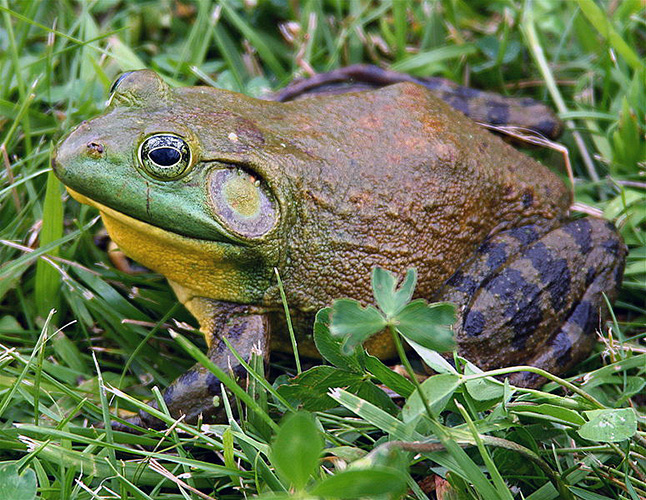
By Emily Spiler
CSISS Program Assistant
A species not native to British Columbia is causing conservationists concern. While many frog populations are in decline worldwide, the American Bullfrog (Lithobates catesbeianus) has been spreading rapidly in BC and outcompeting — or devouring — other native frogs and animals.
The American Bullfrog is native to eastern North America and introduced to the western United States through human interaction. On Vancouver Island, Bullfrog farms were created in the 1930s in an attempt to market frog legs. The released stocks from these farms are believed to be the source of the Bullfrog population along BC’s coast.
Bullfrogs were also imported for use in aquatic gardens and the pet trade, later being released from their ponds or aquariums into wetland habitats. In BC, bullfrogs are currently found on Vancouver Island, the Lower Mainland, and recently in the South Okanagan and Central Kootenay border region. In this new environment, Bullfrogs are lacking their usual predators, like snapping turtles, to keep the population in check.

The American bullfrog is the largest frog in North America, and reproduces rapidly. It can be identified by its size for mature adults; reaching up to 20 cm in length and up to 800 g in weight. The size and strength of the American Bullfrog makes them great competitors, often defending their territory taking food and habitat away from native amphibians. Other identifying features of the American Bullfrog include its smooth skin without warts, yellow throats on males, and large circular eardrums or tympanum behind the eye. They have a distinct loud, low-pitch call.
These aggressive, voracious predators can consume just about anything including native amphibians, fish (including their eggs and larvae), rodents, snakes, turtles, songbirds, and even ducklings. There is evidence that new or increasing bullfrog populations drastically decrease native frog populations. Native frogs in BC that could be impacted include the Western Toad, Pacific Chorus Frog, Columbia Spotted Frog, the Great Basin Spadefoot in the South Okanagan (Threatened), and the Northern Leopard Frog (Endangered).
Currently, there are no known populations within the Columbia-Shuswap region, the nearest population is located in Creston and is reportedly spreading north. If you see or hear a new bullfrog colony, you can report your observations to the Columbia Shuswap Invasive Species Society (CSISS): http://columbiashuswapinvasives.org/contact-us/
Additionally, you can help by not moving frogs or their tadpoles, as it is illegal under the Wildlife act to capture, transport, keep or sell wild animals including bullfrogs. If you have an aquarium or other pets, “Don’t Let It Loose” and avoid releasing them into the wild.
To learn more visit Frogwatch: http://www.env.gov.bc.ca/wld/frogwatch/publications/factsheets/frogs/bullfrog.htm
Please activate the YouTube player below to learn how to identify a bullfrog call:
The Columbia Shuswap Invasive Species Society is a non-profit organization dedicated to the prevention, management and reduction of invasive species in the Salmon Arm, Revelstoke and Golden areas. CSISS is thankful for the generous support of the Columbia Basin Trust, the Columbia Shuswap Regional District, and the province, as well as other regional partners.



